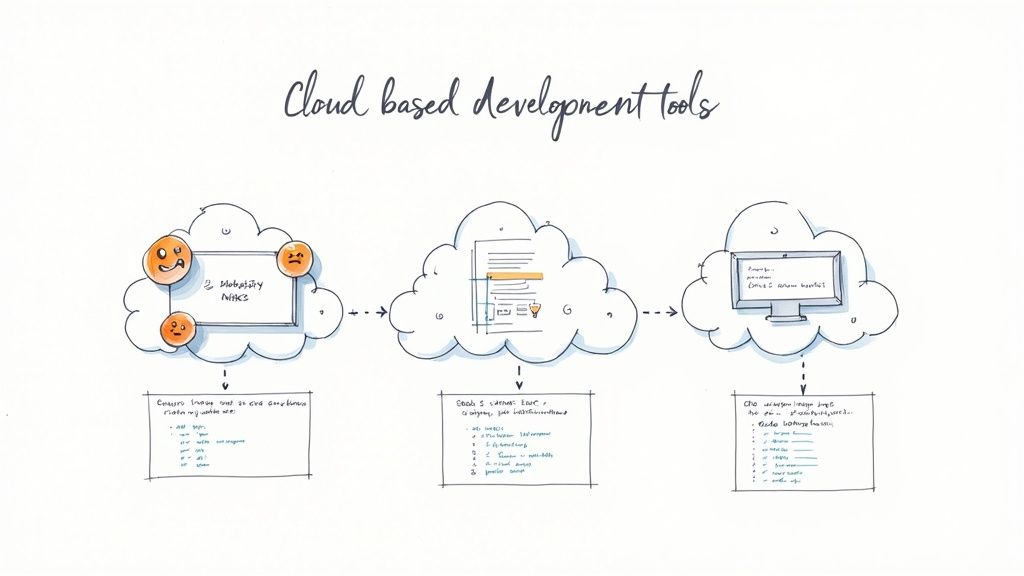Latest Web Dev Trends & Insights
Mastering Mobile-First Development

The dominance of mobile browsing has changed how we build for the web. With smartphones driving nearly 60% of global website traffic as of late 2022, developers must now prioritize mobile experiences from the start. This means beginning the design and development process with smaller screens in mind, then expanding features and layouts for larger devices.
Designing for the Mobile Experience
Creating great mobile experiences requires more than just making a website fit different screen sizes. We need to work within the unique constraints of mobile devices while taking advantage of their capabilities. This includes carefully considering limited screen space, optimizing for touch interactions, and ensuring content loads quickly for users on the go. Popular apps like Instagram and Twitter show how to deliver complex features in simple, intuitive mobile interfaces that work well even with spotty connections.
Performance Optimization for Mobile
Speed makes or breaks the mobile experience. Research shows that just one second of extra load time can reduce conversions by 7%, directly impacting business results. To keep mobile sites fast and responsive, developers should focus on key optimizations like:
- Compressing and properly sizing images
- Reducing server requests
- Setting up effective browser caching
Think of it like fine-tuning an engine - every small performance improvement adds up to create a smoother overall experience.
Beyond Responsive Design: Embracing Mobile-First
While responsive design helps websites adapt to different screens, truly mobile-first development considers the full context of mobile users. This includes factors like:
- Location awareness to provide relevant local content
- Network conditions that may limit bandwidth
- Brief attention spans that demand focused experiences
- Touch-friendly interfaces with larger tap targets
- Single-handed usage patterns
Leading websites succeed by building specifically for mobile behaviors rather than just scaling down desktop designs. They create focused experiences that work naturally on phones and tablets, driving better engagement through thoughtful mobile-first design. This approach requires viewing mobile as the primary platform rather than an afterthought.
Choosing and Implementing Modern Frameworks
Making smart technical decisions is essential for building successful web projects. The framework you choose shapes everything from development speed to long-term maintainability. Let's explore how to select and implement the right framework for your specific needs.
Key Considerations in Framework Selection
Choosing a framework requires looking beyond current trends to evaluate what truly matters for your project. The scope and complexity of what you're building should guide your decision. A smaller project like a basic company website might work well with Svelte, while complex applications often benefit from established options like React. It's similar to choosing the right tool for a job - you wouldn't use a sledgehammer to hang a picture frame.
Speed and responsiveness needs vary significantly between projects. Some frameworks excel at specific performance aspects - Solid shines when you need lightning-fast updates and minimal overhead. This matches well with applications where every millisecond counts, like real-time dashboards or interactive data visualizations.

Your team's experience level with different technologies matters too. If your developers know Vue.js inside and out, sticking with it for new projects can speed up development and reduce errors. Think of it like speaking a language - you'll communicate more effectively in one you already know well.
Implementing React, Vue.js, and Emerging Options
React continues to be a solid choice for interactive interfaces, thanks to its component model and strong community support. Vue.js offers an approachable learning curve while delivering powerful features like reactive data binding and flexible components.
Newer options like Solid and Svelte bring fresh approaches to old problems. Solid's fine-grained reactivity system can deliver excellent performance for data-heavy applications. Svelte takes a different path by moving work to compile time, which can mean smaller code bundles and faster page loads.
Migration Strategies and Performance Benchmarks
Moving to a new framework doesn't have to be overwhelming. A step-by-step approach works well - replace small parts of your application one at a time while keeping the rest stable. This method lets you test thoroughly and maintain a working system throughout the transition.
Measure the impact of framework changes with concrete performance data. Use tools like Lighthouse to track metrics such as load times and Time to First Byte. These numbers help prove the value of framework updates to project stakeholders and guide optimization efforts.
By carefully weighing these factors - project needs, team skills, and performance requirements - you can select and implement a framework that serves your project well both now and as it grows.
AI and Machine Learning in Modern Development
As web development frameworks continue to evolve, artificial intelligence (AI) and machine learning (ML) have become essential tools rather than just trendy concepts. These technologies now solve real development challenges by handling repetitive tasks, allowing developers to focus on creative problem-solving and strategic work that requires human insight.
Smart Code Completion and Generation
Code completion powered by AI acts like an experienced co-developer who anticipates your next steps. Modern development tools can analyze your existing codebase to suggest relevant completions, which speeds up coding and reduces common errors. For example, when working with unfamiliar APIs, AI assistants can generate functional code blocks from simple text descriptions - similar to having an expert guiding you through new territory.
Smarter Testing Methods
Testing has traditionally required significant manual effort to create and run test cases. Now, AI-based testing tools can automatically generate test scenarios, run them across multiple platforms, and catch potential issues before they affect users. This automation gives development teams more time to build new features and improve core functionality instead of getting bogged down in repetitive testing tasks.
Better Performance Through Data
AI's impact extends beyond the development phase into live applications. ML algorithms can study how users interact with a website and adjust the experience accordingly. A site might learn which content formats work best for different visitors and automatically adapt its layout and recommendations. These data-driven improvements lead to faster load times, better engagement, and happier users, especially during high-traffic periods.
What's Next for AI in Development
AI and ML tools will continue shaping how we build for the web. As these technologies mature, they'll become even more central to development workflows. This creates opportunities for developers to build new skills and create better web experiences. The key is choosing AI tools that solve specific problems rather than chasing every new trend. Teams that thoughtfully integrate AI capabilities that match their needs will be better positioned to build excellent web applications. Success comes from understanding both the potential and limitations of AI in your development process.
Building Truly Inclusive Digital Experiences

Web accessibility has become essential for creating successful digital products. Every user, regardless of their abilities, should be able to easily use and enjoy websites and applications. This fundamental shift in web development affects how we approach design, development, and testing to ensure truly inclusive experiences.
Designing With Accessibility in Mind
Creating inclusive experiences starts with thoughtful planning from day one. Here's what that means in practice:
- Understanding WCAG Guidelines: The Web Content Accessibility Guidelines (WCAG) provide clear standards for making content accessible to people with visual, hearing, physical, and cognitive disabilities. Following these guidelines helps ensure no user gets left behind.
- Prioritizing Keyboard Navigation: Many people rely on keyboards or assistive devices to browse the web. Think of someone managing tasks one-handed while holding a baby - they need to access every menu and button without a mouse. Making all interactive elements work with keyboard controls opens up your site to more users.
- Providing Clear and Concise Content: Simple language and logical structure help everyone, especially those with cognitive disabilities. It's like giving directions - using clear signposts and simple explanations makes the journey smoother for all travelers.
When applied consistently, these principles create a better experience for every visitor to your site.
Implementing Accessibility Features
Good design principles need proper technical execution. Here are key development practices that build accessibility:
- Semantic HTML: Using the right HTML elements provides crucial context for assistive technologies. Just as road signs use standard shapes and colors, semantic HTML elements like
<nav>and<article>give clear signals about content structure. - ARIA Attributes: ARIA labels add extra context that screen readers can announce to users. For example, a "Close" button becomes much more useful when ARIA tells users exactly what they're closing.
- Alternative Text for Images: Well-written alt text paints a picture for users who can't see images. Like an audio description track for a movie, it ensures everyone can follow the story being told.
These technical foundations make your content truly accessible to all users.
Testing and Iteration
Building accessible sites requires ongoing attention and refinement through:
- Automated Testing Tools: Regular scans catch common issues early, like checking your car's dashboard warning lights to spot problems before they grow.
- Manual Testing: Having real users with different abilities test your site reveals issues that automated tools might miss. Their direct feedback helps create genuinely useful improvements.
- User Feedback: Actively collecting and responding to user input helps sites evolve to serve everyone better. What works in theory might need adjustments in practice.
By making accessibility central to web development, we create better experiences for all users while building a more inclusive internet. This approach not only expands your site's reach but also demonstrates a real commitment to serving every visitor well.
Implementing Modern Security Best Practices
Strong security needs to be integrated into every stage of web development, not added as an afterthought. A properly secured website protects both user data and your business reputation. By taking a proactive approach to security from the start, development teams can prevent issues rather than scramble to fix breaches after they occur.
Zero-Trust Architecture: Minimizing the Attack Surface
Modern web security has evolved beyond simple perimeter defenses to embrace zero-trust architecture. This approach treats every user and device as potentially risky, requiring continuous verification even after initial authentication. For instance, when an employee accesses company resources, the system checks their credentials, location, device status and behavior patterns before granting specific permissions. As a result, if an attacker compromises one account or system, they can't freely move through the network.
API Security: Guarding the Gateways
As the connective tissue between modern web applications, APIs need robust protection against attacks. This requires implementing several key security measures. Strong authentication confirms user identity, while thorough input validation blocks injection attempts. Regular monitoring helps detect unusual patterns that could signal an attack. Setting rate limits also prevents bad actors from overwhelming APIs with too many requests. These layered defenses work together to keep API connections secure.
Protecting User Data: A Top Priority
Safeguarding user data isn't optional - it's essential for maintaining trust and meeting legal requirements. Using strong encryption like AES-256 protects information both during transmission and storage by making it unreadable without the right keys. Following data privacy laws like GDPR and CCPA demonstrates your commitment to handling user information responsibly. When users know their data is protected, they're more likely to trust and engage with your service.
Training Your Team: Building a Security Culture
Security measures only work when the whole development team understands and follows them consistently. Regular training helps developers recognize common vulnerabilities like cross-site scripting and SQL injection while teaching them prevention techniques. Code reviews and security audits reinforce good practices by catching issues early. For example, having senior developers check new code for security flaws helps junior team members learn secure coding habits. This creates an environment where security awareness becomes second nature.
Navigating Industry Growth and Career Development

As web development grows and changes, developers face both new possibilities and key challenges in their careers. Success requires actively developing your skills and staying current with the latest approaches. With the web design industry reaching $41.8 billion in value in 2022, understanding where the field is headed matters more than ever for both individual developers and teams looking to excel.
Essential Skills for the Modern Web Developer
To stay competitive, developers need to focus on the skills that matter most right now. Mobile development expertise has become crucial, since phones now drive almost 60% of all website traffic. Working with AI tools for code completion, testing, and optimization is also increasingly important. On top of this, creating websites that work well for all users requires solid knowledge of accessibility best practices and how to implement them properly.
Specialization: The Key to Standing Out
As web development becomes more complex, focusing on specific areas can help you build valuable expertise. You might choose to master popular frameworks like React or Vue.js, or explore newer options like Solid and Svelte. But specializing doesn't mean ignoring the basics - strong HTML, CSS, and JavaScript skills provide the foundation you need to learn new tools quickly. Think of it like building a house: you need solid fundamentals to support any specialized features.
Adaptability and Continuous Learning
With web development tools and techniques constantly evolving, ongoing learning is essential to stay relevant. The growing adoption of frameworks like React and Vue.js shows how quickly the field changes. This means developers need to pick up new technologies quickly and adjust their skills to match what the industry needs. Getting involved in developer communities, going to workshops and conferences, and earning certifications all help you keep growing and stay valuable in a changing job market.
Career Planning and Growth Strategies
Planning your career path carefully helps you make the most of opportunities in web development. Start by setting clear goals, identifying roles you want to pursue, and mapping out the skills you'll need. For example, if you aim to become a lead front-end developer, focus on mastering advanced JavaScript, getting really good with one framework, and developing leadership abilities. Building connections with other developers and attending industry events can open doors and give you insights into different career paths. With web developer jobs expected to grow 16% from 2022 to 2032 in the U.S., there are plenty of chances to advance for those who plan ahead.
Are you looking to improve your customer service and grow your business? Sitebot offers AI chatbots that match your content and brand perfectly. Add a smart, multilingual chatbot to your website or platforms like Slack and Zendesk with ease. Visit https://sitebot.co today to learn more.


